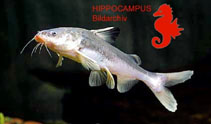http://www.fishbase.org/Summary/speciesSummary.php?genusname=Arius&speciesname=gigas ---> http://193.10.57.58/Summary/speciesSummary.php?genusname=Arius&speciesname=gigas
http://193.10.57.58/Summary/speciesSummary.php?genusname=Arius&speciesname=gigas ---> http://193.10.57.58/summary/Arius-gigas.html
Carlarius gigas, Giant sea catfish : fisheries

You can
sponsor
this page
Common name (e.g. trout)
Genus + Species (e.g. Gadus morhua)
-

-
About this page
-
Languages
-
User feedbacks
-
Citation
-
Uploads
-
Related species
-


 Giant sea catfish
Upload your
photos
and
videos
Giant sea catfish
Upload your
photos
and
videos
Pictures
|
Google image
 Carlarius gigas
Carlarius gigas
Picture by
Hippocampus-Bildarchiv
Teleostei (teleosts) >
Siluriformes
(Catfishes) >
Ariidae
(Sea catfishes) > Ariinae
Etymology:
Carlarius:
First part of the generic name honors Dr. Carl Ferraris, Research Associate at the California Academy of Sciences for his contribution to the knowledge of Siluriformes fishes and continuous support and encouragement throughout the development of this work; the second part is from the frequently used generic name
Arius
.
.
More on author:
Boulenger
.
Environment: milieu / climate zone / depth range / distribution range
Ecology
Freshwater; brackish; benthopelagic. Tropical
Africa: Ouémé and Volta rivers, and greater part of the Niger River basin, including the Benue River downstream Gauthiot Falls (Ref.
57224
)
Size / Weight / Age
Maturity: L
m
?
range ? - ? cm
Max length : 165 cm TL male/unsexed; (Ref.
6541
); max. published weight: 50.0 kg (Ref.
3799
)
Dorsal
spines
(total): 2;
Dorsal
soft rays
(total): 7;
Anal
soft rays
: 11 - 13. Diagnosis: body elongated and rounded; head broad and only slightly flattened above, snout rounded (slightly pointed in small specimens); mouth inferior; maxillary barbels just reaching to pectoral fin bases, mandibular ones being shorter; osseous head shield, fairly visible through the skin, coarsely rugose with a very slight median keel; occipital process moderately broad at base and truncated posteriorly (Ref.
57224
). Base of supra-occipital process moderately wide (Ref.
2683
). Predorsal plate rugose, crescent-shaped; premaxillary teeth villiform forming 2 plates meeting at midline; palatine teeth in 2 large subtriangular patches which are only slightly separated at midline; no gill-rakers on posterior face of the 1st and 2nd arches; total number of anterior gill-rakers on first arch 18 to 21, on second arch 18 to 20; dorsal and pectoral fins with a strong osseous, erectile spine with anterior rim granulose and posterior rim serrated; long dorsal fin spine preceded by a very short one; adipose fin well developed; caudal fin forked, upper lobe slightly elongated (Ref.
57224
). Coloration: bluish grey on the upper part, lightening progressively towards belly which is white; distal rim of fins blackish (Ref.
57224
).
Found in large rivers and their estuaries (Ref.
2683
). Probably exceeds 165 cm (Ref.
3876
). Males practise buccal incubation (ref.
57224
).
Life cycle and mating behavior
Maturity
|
Reproduction
|
Spawning
|
Eggs
|
Fecundity
|
Larvae
Schneider, W.
, 1990. FAO species identification sheets for fishery purposes. Field guide to the commercial marine resources of the Gulf of Guinea. Prepared and published with the support of the FAO Regional Office for Africa. Rome: FAO. 268 p. (Ref.
2683
)
IUCN Red List Status (Ref.
130435
)
Data deficient (DD)
; Date assessed:
18 December 2019
CITES
Not Evaluated
Not Evaluated
Threat to humans
Traumatogenic (Ref.
58010
)
Human uses
Fisheries: commercial
FAO - Publication:
search
|
FishSource
|
More information
Countries
FAO areas
Ecosystems
Occurrences
Introductions
Stocks
Ecology
Diet
Food items
Food consumption
Ration
Common names
Synonyms
Metabolism
Predators
Ecotoxicology
Reproduction
Maturity
Spawning
Spawning aggregation
Fecundity
Eggs
Egg development
Age/Size
Growth
Length-weight
Length-length
Length-frequencies
Morphometrics
Morphology
Larvae
Larval dynamics
Recruitment
Abundance
BRUVS
References
Aquaculture
Aquaculture profile
Strains
Genetics
Electrophoreses
Heritability
Diseases
Processing
Nutrients
Mass conversion
Collaborators
Pictures
Stamps, Coins Misc.
Sounds
Ciguatera
Speed
Swim. type
Gill area
Otoliths
Brains
Vision
Tools
E-book
|
Field guide
|
Identification keys
|
Length-frequency wizard
|
Life-history tool
|
Point map
|
Classification Tree
|
Catch-MSY
|
Special reports
Check for Aquarium maintenance
|
Check for Species Fact Sheets
|
Check for Aquaculture Fact Sheets
Download XML
Summary page
|
Point data
|
Common names
|
Photos
Internet sources
AFORO (otoliths) |
Aquatic Commons
|
BHL
|
Cloffa
|
BOLDSystems
|
Websites from users
|
Check FishWatcher
|
CISTI
|
Catalog of Fishes
:
genus
,
species
|
DiscoverLife
|
ECOTOX
| FAO - Publication:
search
|
Faunafri
| Fishipedia |
Fishtrace
| GenBank:
genome
,
nucleotide
| GloBI |
Google Books
|
Google Scholar
|
Google
| IGFA World Record |
MitoFish
|
Otolith Atlas of Taiwan Fishes
|
PubMed
| Reef Life Survey | Socotra Atlas |
Tree of Life
| Wikipedia:
Go
,
Search
| World Records Freshwater Fishing |
Zoological Record
Estimates based on models
Phylogenetic diversity index (Ref.
82804
): PD
50
= 0.5000 [Uniqueness, from 0.5 = low to 2.0 = high].
Bayesian length-weight: a=0.00525 (0.00269 - 0.01023), b=3.11 (2.94 - 3.28), in cm total length, based on LWR estimates for this (Sub)family-body shape (Ref.
93245
).
Trophic level (Ref.
69278
): 3.9 ±0.6 se; based on size and trophs of closest relatives
Resilience (Ref.
120179
): Very Low, minimum population doubling time more than 14 years (Preliminary K or Fecundity.).
Fishing Vulnerability (Ref.
59153
): Very high vulnerability (90 of 100).
Price category (Ref.
80766
):
Medium
.
Nutrients (Ref.
124155
): Calcium = 57.7 [12.9, 215.0] mg/100g; Iron = 0.575 [0.325, 1.007] mg/100g; Protein = 16.6 [14.9, 18.5] %; Omega3 = 0.136 [0.070, 0.271] g/100g; Selenium = 90 [41, 200] μg/100g; VitaminA = 18 [6, 51] μg/100g; Zinc = 2.06 [0.48, 6.89] mg/100g (wet weight);
Back to Search
Random Species
Back to Top
Accessed through:
Not available
FishBase mirror site :
localhost
Page last modified by :
mrius-barile
- 20 July 2016
Fatal error
: Uncaught ArgumentCountError: Too few arguments to function checkEcotox(), 1 passed in /var/www/html/summary/speciessummary.php on line 2304 and exactly 3 expected in /var/www/html/includes/speciessummary.lib.php:2579 Stack trace: #0 /var/www/html/summary/speciessummary.php(2304): checkEcotox() #1 {main} thrown in
/var/www/html/includes/speciessummary.lib.php
on line
2579
|